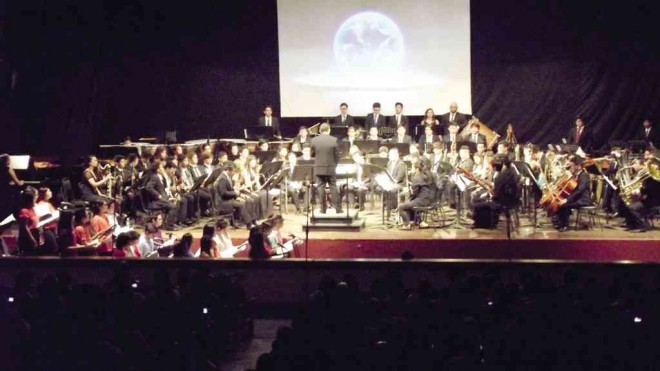
Symphonic band concert gets a big boost with the recent performance of the University of the Philippines Symphonic Band before a big audience at the UP Abelardo Hall.
The performance was held on the first day of the three-day congress of the Southeast Asian Directors of Music (Seadom) hosted by the UP College of Music.
The performance of a concert band, as distinguished from the marching band, is rarely mounted on the concert stage. One has to go places outside Metro Manila to catch a serenata (serenade), the popular name of the concert of a symphonic band held in the town’s plaza at dusk or after dinner.
The symphonic band sounds like a symphony orchestra. Compositions as well as transcribed or arranged symphonic works in this genre make up its program.
Gustav Holst’s monumental suite “The Planets,” transcribed for the concert band by Merlin Patterson, and Johan de Meij’s Symphony No. 3, “Planet Earth were the main fare of the symphonic band concert, concluded by “Travelogue,” a work of Satoshi Yagisawa, a delegate to the congress.
The first two works require big instrumentation. The stage was practically occupied by the musicians who played in their black gala attire.
On the podium was young conductor Rodney Ambat, who wielded the baton with a convincing command despite his youth. He surged through the two gigantic works with a solid dispatch, displaying stamina and zest.
One discerned the conductor’s thorough understanding of the works he conducted. Unfaltering, he decisively led the musicians who played with burning passion into heights of symphonic glory that stunned the audience led by National Artist for Music Ramon P. Santos.
Ambat conveyed the essence of the seven planets thus: Mars, The Bringer of War; Venus, The Bringer of Peace; Mercury, The Winged Messenger; Jupiter, The Bringer of Old Age; Uranus, The Magician; and Neptune, The Mystic.
In “Mars,” Rodney etched a massive texture that would again be felt in “Jupiter.” The lightness of “Mercury” was contrasted with the heaviness in “Saturn.” At the end, a poignant quietude was evoked in “Neptune,” which made use of women’s voices, intoned at the pit by members of the college’s chorus classes prepared by professor Beverly Shangkuan Cheng and cued by professor Eudenice Palarauan.
Rendered almost in an hour, the concert band was on again after a brief interval. This time, the band played another work whose theme again dealt with the solar system, De Meij’s “Planet Earth.”
De Meij continues where Holst stops: He spices his work with the employment of the same women choir. For effect, which is almost cinematic, he uses electronic sound that precedes the band’s rendition, which effectively provides the proper mood and atmosphere for intense listening.
Moving hymn
The band under Ambat once more surged through the entire work with cheerful readiness. From the massive sound of the first movement, the band literally shifted gear to convey the pristine beauty of Earth in the second and the last movements.
Aptly titled “Mother Earth,” the last movement movingly tugged the listeners’ heart as the band, together with the women chorus, wove a moving hymn for Mother Earth, humankind’s bountiful home.
With “Travelogue” as its last rendition, the composer properly acknowledged on stage at the end, the band practically performed for about two hours. Considering that the instruments were blown instruments, one should commend the stamina and enthusiasm of the band’s young musicians who played with gusto.
Off stage, UP Music dean Jose Buenconsejo acknowledged the delegates’ commendation of the UP Symphonic Band.